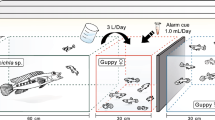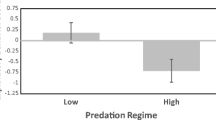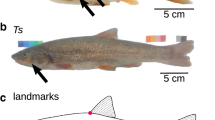Synopsis
In Venezuela, guppies,Poecilia reticulata, are found in a diversity of aquatic ecosystems fringing the western slope of the eastern Andes. These inland drainages are associated with large between-site variation in both physical and biotic environments. Numbers of potential guppy predators vary greatly between low diversity piedmont streams and high diversity llanos swamps. We analyze geographic variation in several phenotypic traits associated with conspicuousness of male guppies as an independent test of Haskins' (Haskins et al. 1961) hypothesis of natural balance between sexual selection (driving male conspicuousness) and predation (driving crypsis). Four sites were compared: a diverse llanos swamp (high predation), two Andean piedmont streams (intermediate and low predation), and a spring pool located south of Venezuela's Paría Peninsula (no aquatic predators). Because tropical wet and dry seasons are associated with varying degrees of environmental change at these sites, within-site seasonal samples provided an additional test of the role of selective predation on Male phenotypes. Phenotypic traits associated with both size and coloration supported the sexual selection/predation hypothesis. male guppies from the spring were generally more colorful than male guppies from inland drainages. Males from the diverse swamp site were smaller and less colorful than guppies from other sites. Males from the swamp population were smallest and least colorful during the early dry season, when diurnal aquatic piscivores were more diverse and abundant. Dominant spot pigments at each site were generally those that provided greatest contrast with the predominant environmental background color, lending further evidence that coloration patterns in male guppies enhance conspicuousness.
Similar content being viewed by others
References
Borowsky, R. 1973. Relative size and the development of fin coloration in Xiphophorus variatus. Physiol. Zool. 46: 22–28.
Darwin, C. 1871. The descent of man and selection in relation to sex. John Murray, London. 671 pp.
Endler, J.A. 1978. A predator's view of animal color patterns. Evol. Biol. 11: 319–364.
Endler, J.A. 1980. Natural selection on color patterns in Poecilia reticulata. Evolution 34: 76–91.
Endler, J.A. 1983. Natural and sexual selection on color patterns in poeciliid fishes. Env. Biol. Fish. 9: 173–190.
Endler, J.A. 1987. Predation, light intensity and courtship behaviour in Poecilia reticulata (Pisces: Poeciliidae). Anim. Behav. 35: 1376–1385.
Fisher, R.A. 1958. The genetical theory of natural selection, 2nd ed. Dover Publications, New York, 291 pp.
Hailman, J.P. 1977. Optical signals: animal communication and light. Indiana University Press, Bloomington. 362 pp.
Haskins, C.P. E.F. Haskins, J.J.A. McLaughlin & R.E. Hewitt. 1961 Polymorphism and population structure in Lebistes reticulatus, a population study. pp. 320–395. In: W.F. Blair (ed.) Vertebrate Speciation, University of Texas Press, Austin.
Kodric-Brown, A. 1985. Female preference and sexual selection for male coloration in the guppy (Poecilia reticulata). Behav. Ecol. Sociobiol. 17: 199–205.
Lewontin, R.C. 1965. Selection for colonizing ability. pp. 77–94. In: H.G. Baker & G.L. Stebbins (ed.) The Genetics of Colonizing Species, Academic Press, New York.
Liley, N.R. & B.H. Seghers. 1975 Factors affecting the morphology and behavior of guppies in Trinidad. pp. 92–118 In: G.P. Baerends, C. Beer & A. Manning (ed.) Function and Evolution in Behavior, Oxford University Press, Oxford.
Reznick, D. & J.A. Endler. 1982. The impact of predation on life history evolution in Trinidadian guppies (Poecilia reticulata). Evolution 36: 160–177.
Seghers, B.H. 1974. Geographic variation in the responses of guppies (Poecilia reticulata) to aerial predators. Oecologia 14: 93–98.
Sokal, R.R. & F.J. Rohlf. 1981. Biometry, 2nd ed. W.H. Freeman and Company, San Francisco. 859 pp.
Snedecor, G.W. & W.G. Cochran. 1980. Statistical methods, 7th ed. Iowa State University Press, Ames. 507 pp.
Stearns, S.C. 1976. Life history tactics: a review of the ideas. Q. Rev. Biol. 51: 3–47.
Winemiller, K.O. 1987a. Investigations of ecomorphological and community level convergence among neotropical fish assemblages. Ph.D. Dissertation, University of Texas, Austin. 370 pp.
Winemiller, K.O. 1987b. Feeding and reproductive biology of the currito, Hoplosternum littorale, in the Venezuelan Ilanos with comments on the possible function of the enlarged male pectoral spines. Env. Biol. Fish. 20: 219–227.
Winemiller, K.O. 1989a. Development of dermal lip protuberances for aquatic surface respiration in South American characid fishes. Copeia 1989: 382–390.
Winemiller, K.O. 1989b. Ontogenetic diet shifts and resource partitioning among piscivorous fishes in the Venezuelan llanos. Env. Biol. Fish. 26: 177–199.
Yamamoto, T. 1975. The medaka, Oryzias latipes, and the guppy, Lebisthes reticulatus. pp. 133–149. In: R.C. King (ed.) Handbook of Genetics, vol. 4, Vertebrates of Genetic Interest, Plenum Press, New York.
Author information
Authors and Affiliations
Rights and permissions
About this article
Cite this article
Winemiller, K.O., Leslie, M. & Roche, R. Phenotypic variation in male guppies from natural inland populations: an additional test of Haskins' sexual selection/predation hypothesis. Environ Biol Fish 29, 179–191 (1990). https://doi.org/10.1007/BF00002218
Received:
Accepted:
Issue Date:
DOI: https://doi.org/10.1007/BF00002218




